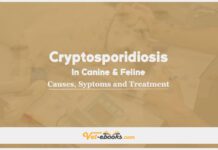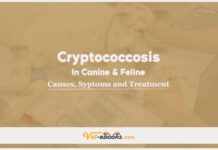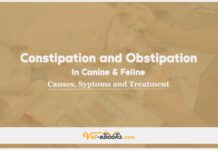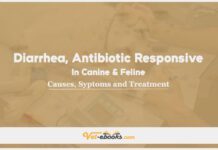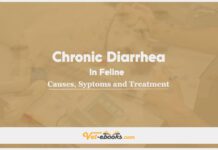Chronic Diarrhea In Canine: Causes, Symptoms and Treatment
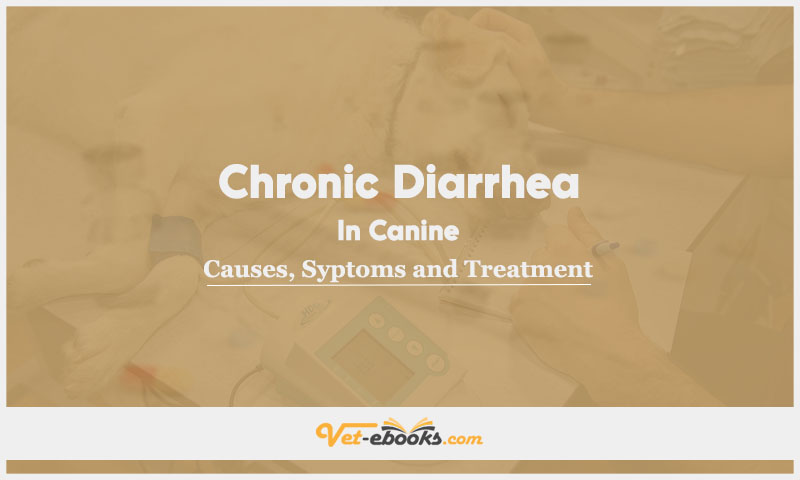
Overview
- Prolonged alterations in the frequency, consistency, and volume of feces persist beyond three weeks.
- Manifest in the small bowel, large bowel, or mixed.
Causes of Chronic Diarrhea In Canine
Causes
Small bowel
Primary Small Intestinal Disease
- Inflammatory bowel disease (lymphoplasmacytic enteritis, eosinophilic enteritis, granulomatous enteritis, and immunoproliferative enteropathy of Basenjis).
- Primary or secondary lymphangiectasia.
- Neoplasia.
- Bacterial (Campylobacter jejuni, Salmonella spp., invasive adherent or enterotoxic E. coli, and other enterobacteriaceae).
- Mycotic infections (histoplasmosis).
- Algal infections (protothecosis and pythiosis).
- Parasites (Giardia, Toxocara, Ancylostoma, Toxascaris leonina, Cryptosporidium, and Cystoisospora).
- Partial obstruction (foreign body, intussusception, or neoplasia).
- Antibiotic-responsive diarrhea (intestinal microbial dysbiosis).
- Short bowel syndrome.
Maldigestion
- Exocrine pancreatic insufficiency.
- Hepatobiliary disease (deficiency of intraluminal bile).
Dietary
- Food-responsive enteropathy.
- Food allergy.
Metabolic Disorders
- Hepatobiliary disease.
- Hypoadrenocorticism.
- Uremic gastroenteritis.
- Adverse drug responses.
- Toxins (enterotoxins, aflatoxins, exotoxins, and their association with food poisoning).
Large bowel
Primary Large Intestinal Disease
- Inflammatory bowel disease (lymphoplasmacytic colitis, eosinophilic colitis, and granulomatous colitis).
- Neoplasia.
- Infections (histoplasmosis, adherent invasive E. coli, Prototheca, and pythiosis).
- Parasites (Trichuris vulpis, Giardia intestinalis, Entamoeba histolytica, and Balantidium coli).
- Ileocolic intussusception.
- Cecal inversion.
Dietary
- Dietary indiscretion, alterations in diet, food-responsive enteropathy, and foreign material (bones, plastic, wood, or hair).
- Responsive large-bowel diarrhea.
Miscellaneous
Irritable bowel syndrome.
Risk factors
Small Bowel
- Dogs that are of a larger breed, younger in age, and exhibit less severe symptoms are more susceptible to developing food-responsive diarrhea.
- Several dog breeds (Yorkshire terriers, West Highland white terriers, Rottweilers, and soft-coated wheaten terriers) have a predisposition to develop lymphangiectasia as a sequel to inflammatory bowel disease.
Large Bowel
- Dietary modifications or lack of adherence, stress, and psychological variables.
- Granulomatous colitis (invasive adherent Escherichia coli) is observed in boxer and French bulldog breeds (less than three years of age).
- Pythiosis is frequently observed in larger breeds that exhibit a greater propensity for outdoor activities (roaming and hunting).
Pathogenesis of Chronic Diarrhea In Canine
- Secretory diarrhea.
- Osmotic diarrhea.
- The permeability has experienced an increase.
- Abnormal GI motility.
- Numerous instances entail the amalgamation of various pathophysiologic pathways.
Symptoms (History & Physical Examination) of Chronic Diarrhea In Canine
History
- Small bowel diarrhea (normal to increased volume of stool, normal to significantly increased frequency of defecation, weight loss, polyphagia, melena, borborygmus, and occasional vomiting).
- Large bowel diarrhea (decrease in stool volume, increase in the frequency of defecation, hematochezia and mucus, tenesmus, urgency, dyschezia, flatulence, borborygmus, and vomiting).
Physical Examination
Small bowel
- Inadequate physical health due to malabsorption, maldigestion, and protein-losing enteropathy.
- Variable dehydration.
- Upon abdominal palpation, thickened small bowel loops, can be either diffuse or segmental.
- This finding is linked with infiltrative disease, abdominal effusion, foreign body, neoplastic tumor, intussusception, or enlarged mesenteric lymph nodes.
- Rectal palpation does not yield any significant findings.
Large bowel
- Normal body state.
- Dehydration (uncommon).
- Upon abdominal palpation, thickened large bowel, foreign body, neoplastic mass, intussusception, or enlarged mesocolic lymph nodes.
- Upon rectal palpation, irregularities, rectal masses located within or outside the lumen, rectal strictures, and sublumbar lymphadenopathy.
Diagnosis of Chronic Diarrhea In Canine
1- From History and Physical Examination
2- Diagnostic Procedures
CBC/BIOCHEMISTRY/URINALYSIS
- Anemia.
- Severe hypoalbuminemia (<2 g/dL) is linked to unfavorable outcomes.
- Panhypoproteinemia may exhibit an association with protein-losing enteropathy (PLE).
- Reactive hepatopathy leads to mild to moderate elevations in liver enzymes, specifically ALT and ALP.
- Dogs with lymphangiectasia often have low cholesterol because their lymphatic fluid loses cholesterol, making it hard for their bodies to absorb it.
OTHER LABORATORY TESTS
- Fecal flotation with centrifugation for identifying eggs and parasites.
- Fecal floatation with ZnSO4 and subsequent centrifugation are suggested for identifying Giardia cysts.
- Direct immunofluorescence assays or SNAP® testing to enhance the diagnostic yield.
- Fecal PCR assay is a viable method for identification and detection of Heterobilharzia americana eggs, Cryptosporidia, and various other infectious illnesses.
- Enzyme immunoassay for detecting histoplasma antigen in serum or urine samples.
- Pythium is identified through the two serological assays (immunoblot assay and ELISA).
- Bacteria are cultivated from intestinal tissue or detected by PCR in infected tissues.
- To rule out the possibility of virus-associated enteritis, this study’s goal is to do serologic screening for FeLV and FIV.
- Cobalamin is measured to assess potential abnormalities.
- Subnormal levels indicate exocrine pancreatic insufficiency, severe illness affecting the mucosa of the ileum, and intestinal dysbiosis.
- Correlation between severe hypocobalaminemia (serum cobalamin level below 200 picograms per milliliter) and unfavorable prognosis.
- Exocrine pancreatic insufficiency is associated with decrease in trypsin-like immunoreactivity (TLI).
- Pancreatitis results in an elevation of canine pancreatic lipase immunoreactivity (spec cPL).
- Fecal alpha-1-proteinase inhibitor assay for the identification of protein-losing enteropathy.
- Canine microbiota dysbiosis index is measured through PCR on fecal samples.
- Canine calprotectin in blood and feces is a valuable biomarker for dogs with chronic diarrhea.
- Fecal calprotectin differentiates between enteropathies that are responsive to diet, antibiotics, and steroids.
- It has been proven that having high levels of perinuclear antineutrophil cytoplasmic antibody (pANCA) is linked to chronic enteropathies, especially those that are triggered by food.
- Atypical Addison’s disease results in the manifestation of chronic gastrointestinal symptoms that exhibit a waxing and waning pattern.
- A cortisol level greater than 2 µg/dL excludes the presence of hypoadrenocorticism.
- If the resting cortisol level is less than 2 µg/dL, conduct an ACTH stimulation test in order to evaluate the adrenal glands’ capacity to respond adequately to stimulation.
- Thyroid testing to assess the presence of hyperthyroidism in cats and hypothyroidism in dogs.
- Bile acids are utilized for the detection of hepatobiliary illness.
Imaging
- Abdominal X-rays can show nothing wrong or show signs of pancreatitis, partial intestinal obstruction, masses, foreign bodies, organomegaly, hepatobiliary illness, and/or effusion.
- Thoracic radiographs exhibit no notable abnormalities, although they reveal metastatic illness or pleural effusion associated with protein-losing enteropathy (PLE).
- Abdominal ultrasonography permits the comprehensive evaluation of all organs within the abdominal cavity.
- Measurement of intestinal wall thickness lacks sensitivity and specificity as a diagnostic indication for chronic enteropathies.
- Echogenicity of the intestinal mucosa is a precise biomarker of inflammatory illness.
- Identification of hyperechoic striations in the duodenum or jejunum indicates protein-losing enteropathy.
- Identification of hyperechoic speckles in the duodenum or jejunum indicates inflammatory illness.
- Ultrasound guidance in the fine needle aspiration of gastrointestinal mass lesions for diagnosis of mast cell tumors, carcinomas, and large cell lymphoma.
3- Differential Diagnosis
- Diet-responsive enteropathy.
- Antibiotic-responsive enteropathy.
- Infectious agents (Giardia, histoplasmosis, feline leukemia virus, feline immunodeficiency virus, Pythium, and helminths).
- Neoplasia (lymphoma, carcinoma, leiomyosarcomas, and mast cell tumors).
- Inflammatory bowel disease.
- Lymphangiectasia.
- Mechanical blockage.
- Irritable bowel disease.
- Exocrine pancreatic insufficiency.
- Pancreatitis, atypical Addison’s, hypothyroidism, hyperthyroidism, renal disease, liver disease (portosystemic shunt), or congestive heart failure.
Treatment of Chronic Diarrhea In Canine
General:
- The management of chronic diarrhea resulting from infectious illnesses or secondary enteropathies necessitates appropriate medical intervention.
- Dietary intervention studies are employed for diagnosing food-responsive enteropathy.
- Antibiotic trials identify cases of antibiotic-responsive enteropathy.
Medications:
- Antibiotic-responsive enteropathy: metronidazole (10–15 mg/kg orally every 12 hours) or tylosin (25 mg/kg orally every 12 hours) for a minimum duration of 10 days.
- Immunosuppressive or steroid-responsive enteropathy: prednisolone or prednisone (0.5–1 mg/kg orally every 12–24 hours), or cyclosporine (5 mg/kg orally every 24 hours).
- When dogs with chronic diarrhea take fiber supplements, their fecal microbiota changes, making their microbiota profile more like that of healthy dogs.
Some Notes:
Anticholinergics worsen the condition in many cases of chronic diarrhea.
Tip
Do You Want To Increase Your Veterinary Knowledge and Practical Skills?
You Can Now Browse and Download +3000 Books For Veterinary Professionals & Students Online.
Download Veterinary Books

